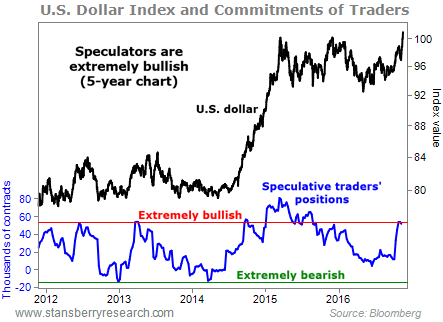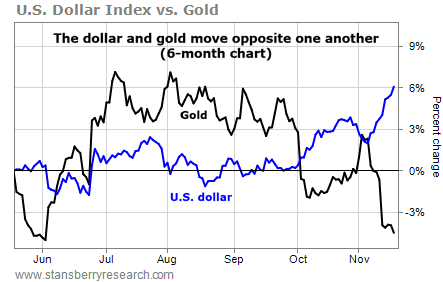One of the world’s most important assets has been building up energy for the better part of two years…
And just last week, it broke out to a 13-year high.
[ad#Google Adsense 336×280-IA]This asset has a major impact on world markets… and on your investment portfolio. So the uptrend in this asset – the U.S. dollar – is worth keeping an eye on.
Today, we’ll look at where the dollar is likely headed. And we’ll review what that means for us, as traders and investors…
Before we get to the price action, you should know two main reasons the dollar is rising.
One is that there are few good alternatives.
A currency is sort of like the share price of a country. The U.S. economy has plenty of problems… But other major economies around the world are in far worse shape.
Would you rather “buy shares” of Europe, Japan, or China? Probably not. And lots of folks around the world, even in Europe and Asia, prefer betting on the U.S., too.
The second reason is that our government bond yields are higher than those in other developed countries. The benchmark 10-year U.S. Treasury has yields of 2.3% today. Japan’s 10-year bonds yield 0%. Germany’s and France’s 10-year bonds yield 0.3% and 0.8%, respectively. Even Italy, which has an unemployment rate of 12% today, has a 2.1% yield on its 10-year bonds.
Those economies are weaker and/or less stable. And the yields are lower. So money flows to the dollar. Over the long term, that trend is likely to continue.
But the dollar is up more than 8% since early May. That’s a big move for a currency in a relatively short time. So the question is, has it run too far, too fast?
Sentiment is a great short-term analytical tool. When speculators get extremely bullish, it’s a sign that there’s not much more money available to push the asset higher. So prices often stall or reverse.
We can see speculators’ bets by looking at the Commitments of Traders (or “COT”) reports. In the five-year chart below, you can see that the U.S. dollar (the black line) peaked most times that speculators’ bets (the blue line) reached extremely bullish levels. The important exception was in late 2014 and early 2015…

Sentiment is extremely bullish… But the dollar broke above its 2015 highs. That’s a major breakout.
We’ll likely see some sort of pullback in the short term. But it looks like big, new highs are coming…
If the dollar does continue higher, it means that U.S. goods and services will cost more for foreign buyers… because their currencies will be weaker by comparison. It also means that foreign goods and services will be cheaper for U.S. buyers.
For U.S.-based businesses, this means weaker international demand. And it means that the things they sell on foreign soil – in foreign currencies – are worth less in dollars. This weighs on dollar-based sales and earnings figures, which in turn weighs on U.S. stocks.
A stronger dollar often means lower commodity prices, too. As the dollar rises, it takes fewer dollars to buy the same asset. For example, if the dollar doubles overnight, dollar owners should be able to buy twice as many ounces of gold, barrels of oil, or pounds of coffee. We see this as a 50% drop in the prices of those commodities.
This doesn’t necessarily mean that U.S. stocks and commodities are headed lower, though. The dollar is an important factor… but it’s one of many.
In the past, there have been plenty of periods when U.S. stocks both rose and fell alongside a rising dollar. And there were periods when stocks rose and fell alongside a falling dollar.
If the dollar continues higher, don’t sell all your stocks. Just pay attention to how much of each business’ revenues come from overseas. The companies that earn most of their money outside of the U.S. will be hurt the worst. So unless you believe they’re strong enough to overcome the headwind, you may want to lighten up on those companies.
As for gold, you can see by a glance at the chart below that gold and the dollar have an inverse relationship. When the dollar rises or falls, gold does the opposite…

This is the normal relationship between the dollar and gold. But again, don’t sell your gold based on this one factor. Relationships between assets can turn “abnormal” for extended periods of time.
It has happened in the past… And natural resource investing legend Rick Rule believes it will happen again. In a recent interview with Kitco News at the Silver & Gold Summit, Rick explained that he expects gold and the dollar to rise together in the coming years…
As I noted above, people put their money into the dollar because there are few good alternatives. But gold has served as money for thousands of years. It is the best alternative to paper currencies, including the dollar.
For now, though, the dollar is on the rise. Gold is down. And the dynamics of global trade could be about to go through some major changes.
A rising dollar is one of the most important economic trends in the world. Make sure you’re paying attention to how it affects your investments.
Good trading,
Ben Morris
[ad#stansberry-ps]
Source: Growth Stock Wire
